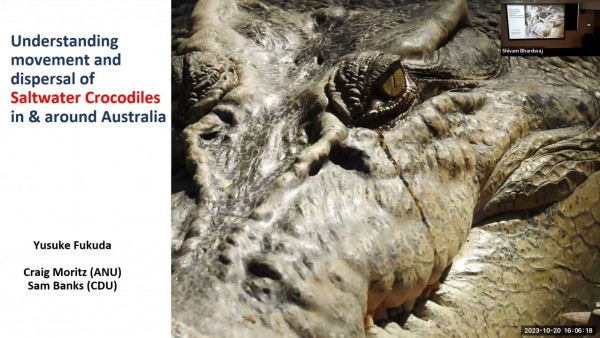E&E PhD Exit Seminar: Understanding the movement and dispersal of saltwater crocodiles in and around Australia
Human-crocodile conflict is becoming a conservation challenge worldwide. The saltwater crocodile (Crocodylus porosus) is the largest (>6 m total length, >1000kg) and most aggressive living crocodilian species being responsible for increasing attacks on people and domestic animals in many countries. This species is highly adapted to saline environments and widely distributed in the Indo-Pacific region. However, their movement and dispersal patterns remain largely unknown. In the first chapter, we examined the spatial events implicated in the homing ability of crocodiles that complicates management interventions aimed at reducing human-crocodile conflict. Five large male crocodiles were shifted and released 100-320 km from their capture sites, and three additional ones were released at their capture site as controls. Translocated crocodiles were more mobile than the controls and moved at sea in the direction of their original capture site. However, they were unable or unwilling to swim around a geographic structure, the Cobourg Peninsula, which prevented homing from being achieved in all five cases. Genetic analysis of tissue samples from nests demonstrated significant genetic structure across the coast and confirmed that Cobourg Peninsula contributes to genetic differentiation among populations along the coast. The second chapter demonstrated environmental influences on crocodiles' dispersal, which comprises emigration, movement and settlement. We found that both environmental resistance and properties of the source and destination catchments (proportion of breeding habitat which limits carrying capacity) were important factors influencing observed dispersal events. Competition for habitat influences emigration and settlement choices, and environmental resistance to movement occurred, in which high-quality habitat was associated with the greatest environmental permeability. Approximately 42% of crocodiles were migrants from populations other than their sampling locations, and some outstandingly productive populations had a much higher proportion of emigration than immigration. The distance most commonly travelled between source and destination was 150-200 km, although a few travelled much longer distances. The third chapter identified the natal origins of 95 crocodiles caught as problem crocodiles in Darwin Harbour where habitats suitable for breeding are extremely limited. Population assignments showed most crocodiles came from populations within 200 km, namely the Adelaide and Mary Rivers and Kakadu region as the most significant source (approximately 50%), the Daly, Finniss and Reynolds Rivers as the second (approximately 30%), and Tiwi Islands as the third (approximately 15%). Attributes such as total length (most commonly 150-180 cm), sex (75% male), and the year of capture (2015-2017) were not significantly correlated to the distance travelled to the harbour. Given that crocodiles found in Darwin Harbour are migrants from multiple sources, we argue that adaptive measures such as removing crocodiles in the defined management zones may be more efficient at reducing risk to public safety than more proactive approaches, such as interfering with populations at the targeted source. The last chapter determined the genetic connectivity among crocodiles in Australia and its neighbouring countries. This chapter showed broad regional patterns of genetic structure in northern Australia and Southeast Asia but connectivity between Papua New Guinea and Queensland populations. For a more comprehensive mapping of the genetic connectivity, more genetic samples are required from the major gaps such as India, Indonesia and Sri Lanka. In conclusion, this study has provided important implications for better understanding crocodiles' dispersal and movement patterns. Our findings can help management reduce conflicts between crocodiles and people.






